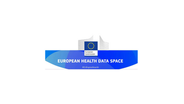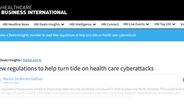- Lloyd Price
Future of medical device cyber security

Exec Summary:
The future of medical device cyber security is a rapidly evolving landscape. As medical devices become increasingly connected to the internet, they are becoming more vulnerable to cyber attacks. In 2021, there were over 100 known cyber attacks on medical devices, and this number is expected to grow in the coming years.
There are a number of factors driving the growth of cyber attacks on medical devices. These factors include:
The increasing connectivity of medical devices: Medical devices are becoming increasingly connected to the internet, which makes them more vulnerable to cyber attacks.
The growing sophistication of cyber attackers: Cyber attackers are becoming more sophisticated and are developing new methods to attack medical devices.
The lack of security in medical devices: Many medical devices are not designed with security in mind, which makes them easy targets for cyber attacks.
The consequences of a successful cyber attack on a medical device can be serious. In some cases, cyber attacks can cause medical devices to malfunction, which can lead to patient harm. In other cases, cyber attacks can be used to steal patient data, which can be used for identity theft or other crimes.
There are a number of steps that can be taken to improve the cyber security of medical devices. These steps include:
Designing medical devices with security in mind: Medical devices should be designed with security in mind from the start. This includes using strong security protocols and implementing security measures to protect patient data.
Keeping medical devices up to date: Medical devices should be kept up to date with the latest security patches. This will help to protect devices from known vulnerabilities.
Educating healthcare workers about cyber security: Healthcare workers should be educated about cyber security risks and how to protect medical devices from attack.
Working with regulators to develop standards: Regulators should work with industry to develop standards for medical device cyber security. This will help to ensure that all medical devices are adequately protected from cyber attack.
The future of medical device cyber security is a complex and challenging one. However, by taking steps to improve the cyber security of medical devices, we can help to protect patients from harm.
Mergers, Acquisitions, Growth and Strategy for Healthcare Technology companies
HealthTech M&A - Buy Side, Sell Side, Growth & Strategy services for companies in Europe, Middle East and Africa. Visit www.nelsonadvisors.co.uk
HealthTech M&A Newsletter from Nelson Advisors - HealthTech, Health IT, Digital Health Insights and Analysis. Subscribe Today! https://lnkd.in/e5hTp_xb
Healthcare Technology Buy Side, Sell Side, Growth & Strategy services for Founders, Owners and Investors. Email lloyd@nelsonadvisors.co.uk
Healthcare Technology Thought Leadership from Nelson Advisors – Market Insights, Analysis & Predictions. Visit https://lnkd.in/ezyUh5i

Key factors likely to shape the future of medical device cybersecurity:
The future of medical device cybersecurity is of paramount importance as the healthcare industry becomes increasingly digitized and interconnected. Here are some key aspects that are likely to shape the future of medical device cybersecurity:
Regulatory focus: Regulatory bodies worldwide, such as the U.S. Food and Drug Administration (FDA) and the European Union's Medical Device Regulation (MDR), are placing greater emphasis on medical device cybersecurity. Future regulations may require manufacturers to implement more stringent cybersecurity measures, conduct risk assessments, and provide ongoing vulnerability management throughout the lifecycle of medical devices.
Enhanced security standards: Industry organizations, manufacturers, and cybersecurity experts are working collaboratively to develop and implement robust security standards for medical devices. This includes the use of secure design principles, encryption, authentication mechanisms, and secure software development practices. Future security standards are likely to evolve and adapt to emerging cybersecurity threats and vulnerabilities.
Increased collaboration: Collaboration among stakeholders, including manufacturers, healthcare providers, cybersecurity experts, and regulatory bodies, will be crucial in addressing medical device cybersecurity challenges. This collaboration can involve sharing threat intelligence, best practices, and lessons learned to enhance the overall security posture of medical devices.
Vulnerability management: Given the evolving nature of cybersecurity threats, proactive vulnerability management is essential. Medical device manufacturers should establish processes to promptly identify, assess, and mitigate vulnerabilities in their devices. This includes timely security updates, patch management, and coordinated disclosure processes to address vulnerabilities discovered by researchers or reported incidents.
Secure software development: Secure software development practices will be increasingly important in ensuring the resilience of medical devices. Manufacturers should implement secure coding practices, conduct thorough security testing, and regularly update software to address newly identified vulnerabilities. The adoption of secure coding frameworks, threat modeling techniques, and secure development lifecycle methodologies will become more prevalent.
Threat detection and response: The ability to detect and respond to cyber threats targeting medical devices will be critical. Intrusion detection and prevention systems, anomaly detection algorithms, and advanced analytics can help identify potential cyber attacks and anomalous device behavior. Implementing robust incident response plans and conducting simulated exercises will enable healthcare organisations to effectively respond to and mitigate cybersecurity incidents.
Education and awareness: Ongoing education and awareness programs will be essential for healthcare providers, manufacturers, and end-users to understand the importance of medical device cybersecurity. Training programs should focus on recognising potential threats, implementing secure practices, and maintaining the security of medical devices throughout their lifecycle.
Adoption of emerging technologies: The future of medical device cybersecurity will also involve the adoption of emerging technologies such as blockchain, AI-based anomaly detection, and secure hardware modules. These technologies offer potential solutions to enhance the security and integrity of medical devices and the data they handle.
It's important to note that medical device cybersecurity is a complex and evolving field, and addressing cybersecurity risks requires a multi-faceted approach involving technology, policies, regulations, and education. Ongoing collaboration, vigilance, and adaptation to emerging threats will be key in ensuring the security and safety of medical devices in the future.

Key future trend: software bill of materials
A software bill of materials (SBOM) is a list of all the software components that make up a software product. SBOMs can be used to improve the security, quality, and efficiency of software development and maintenance.
SBOMs can be created using a variety of tools and methods. Some common methods include:
Manually extracting information from source code: This method is time-consuming and error-prone, but it is the most accurate way to create an SBOM.
Using a static analysis tool: Static analysis tools can scan source code for information about software components. This method is faster and easier than manual extraction, but it is not as accurate.
Using a dynamic analysis tool: Dynamic analysis tools can run software and monitor its behavior to identify software components. This method is the fastest and easiest way to create an SBOM, but it is not as accurate as manual extraction or static analysis.
Once an SBOM has been created, it can be used to improve the security, quality, and efficiency of software development and maintenance.
Security: SBOMs can be used to identify security vulnerabilities in software. This information can then be used to fix vulnerabilities or to mitigate their impact.
Quality: SBOMs can be used to identify quality issues in software. This information can then be used to improve the quality of software before it is released.
Efficiency: SBOMs can be used to improve the efficiency of software development and maintenance. This is because SBOMs can be used to identify dependencies between software components. This information can then be used to automate tasks such as building and testing software.
SBOMs are a valuable tool for improving the security, quality, and efficiency of software development and maintenance. By using SBOMs, organisations can reduce the risk of security vulnerabilities, improve the quality of software, and save time and money.
Here are some of the benefits of using SBOMs:
Improved security: SBOMs can help organizations to identify and mitigate security vulnerabilities in their software. This can help to protect organisations from data breaches and other security incidents.
Improved quality: SBOMs can help organizations to identify and fix quality issues in their software. This can help to improve the reliability and performance of software.
Reduced costs: SBOMs can help organizations to reduce the costs of software development and maintenance. This is because SBOMs can help organisations to automate tasks such as building and testing software.
SBOMs are a valuable tool for organizations of all sizes. By using SBOMs, organisations can improve the security, quality, and efficiency of their software development and maintenance processes.

Key future trend: cyber security risks of virtual wards
Virtual wards are a type of telemedicine that allows patients to receive care remotely from a team of healthcare professionals. This can be done through video conferencing, phone calls, or other electronic means.
Virtual wards can provide a number of benefits for patients, including convenience, cost savings, and improved access to care. However, there are also some cyber security risks associated with virtual wards.
Some of the cyber security risks of virtual wards include:
Data breaches: Virtual wards often use electronic health records (EHRs) to store patient data. This data can be vulnerable to cyber attacks, which could lead to patient information being stolen or compromised.
Malware: Virtual wards can be targeted by malware attacks. This malware could be used to steal patient data, disrupt the delivery of care, or even damage the virtual ward's infrastructure.
Phishing: Virtual wards can be used to launch phishing attacks. These attacks are designed to trick patients into providing personal information, such as passwords or credit card numbers.
Man-in-the-middle attacks: Virtual wards can be vulnerable to man-in-the-middle attacks. These attacks allow attackers to intercept communications between patients and healthcare professionals. This could allow attackers to steal patient data or disrupt the delivery of care.
To mitigate these risks, virtual ward providers should take a number of steps, such as:
Implementing strong security measures: Virtual ward providers should implement strong security measures to protect patient data. This includes using strong passwords and encryption, and keeping software up to date.
Educating patients: Virtual ward providers should educate patients about cyber security risks. This includes teaching patients how to spot phishing attacks and how to protect their personal information.
Working with law enforcement: Virtual ward providers should work with law enforcement to investigate and prosecute cyber attacks. This will help to deter future attacks and protect patients.
By taking these steps, virtual ward providers can help to protect patient data and ensure the safety of virtual wards.
Virtual wards, which provide remote monitoring and care for patients outside of traditional hospital settings, present unique cybersecurity risks. While they offer benefits in terms of patient care and resource optimisation, it's crucial to address the following cybersecurity risks associated with virtual wards:
Data privacy and confidentiality: Virtual wards involve the collection, storage, and transmission of sensitive patient health data. Maintaining patient privacy and confidentiality is paramount. Risks include unauthorized access to patient data, data breaches, and inadequate data protection measures. Robust encryption, access controls, and secure data storage protocols should be implemented to safeguard patient information.
Network security: Virtual wards rely on network connectivity and the exchange of patient data between healthcare providers and patients. Inadequately secured networks or unsecured Wi-Fi connections can expose virtual ward systems to various cyber threats, including unauthorized access, data interception, and man-in-the-middle attacks. Strong network security measures, such as encryption, firewalls, and regular vulnerability assessments, are crucial to mitigate these risks.
Device security: Medical devices used in virtual wards, such as remote monitoring devices or wearable sensors, may be vulnerable to cyber attacks. Compromised devices can lead to unauthorized access, tampering with data, or disruption of patient care. Implementing strong device security measures, including secure firmware, authentication mechanisms, and regular patching and updates, is essential to protect against device-level cyber risks.
Malware and ransomware attacks: Virtual wards can be targeted by malware and ransomware attacks, which can disrupt operations, compromise patient data, and lead to financial losses. Robust endpoint security solutions, regular software updates, and user awareness training can help mitigate these risks. Backup and disaster recovery plans should also be in place to minimize the impact of ransomware attacks.
Social engineering and phishing: Social engineering attacks, such as phishing emails or phone scams, can trick healthcare providers or patients into divulging sensitive information or granting unauthorized access. Comprehensive cybersecurity awareness training programs should be implemented to educate staff and patients about recognising and responding to social engineering attacks.
Insider threats: Virtual wards may face risks from insider threats, including unauthorized access or misuse of patient data by healthcare employees. Strong access controls, user authentication mechanisms, and strict security policies can help mitigate these risks. Regular auditing and monitoring of system activity can also detect and prevent potential insider threats.
Regulatory compliance: Virtual wards must adhere to relevant regulations and standards, such as HIPAA in the United States or GDPR in the European Union, which outline requirements for the protection of patient data and privacy. Compliance with these regulations, including data encryption, data breach notification, and access controls, is essential to avoid legal and financial consequences.
Addressing these cybersecurity risks requires a multi-layered approach, including robust technical controls, staff education, policy development, and ongoing risk assessments.
Collaboration among healthcare organizations, technology vendors, and cybersecurity experts is crucial to stay ahead of evolving cyber threats and ensure the security and privacy of virtual ward environments.

Key future trend: remote patient monitoring
Remote patient monitoring (RPM) is a healthcare technology that allows healthcare providers to monitor patients remotely. RPM devices collect data from patients, such as vital signs, blood pressure, and heart rate, and transmit the data to healthcare providers. This data can be used to track patients' health, identify potential problems, and make treatment decisions.
RPM has a number of benefits, including:
Improved patient care: RPM can help to improve patient care by allowing healthcare providers to monitor patients more closely and identify potential problems early.
Reduced costs: RPM can help to reduce costs by reducing the need for in-person visits to healthcare providers.
Increased patient satisfaction: RPM can help to increase patient satisfaction by making it easier for patients to access care and by providing them with more control over their health.
However, RPM also has some security risks. These risks include:
Data breaches: RPM devices collect sensitive patient data, which could be stolen by hackers.
Malware attacks: RPM devices could be infected with malware, which could disrupt the monitoring process or steal patient data.
Denial-of-service attacks: RPM devices could be targeted by denial-of-service attacks, which could prevent patients from accessing their care.
To mitigate these risks, healthcare organisations should take the following steps:
Use secure devices: Healthcare organisations should use secure RPM devices that have been designed with security in mind.
Implement security measures: Healthcare organisations should implement security measures to protect their RPM devices, such as firewalls, intrusion detection systems, and encryption.
Train employees: Healthcare organisations should train their employees on cybersecurity best practices, such as how to identify and report suspicious activity.
Work with vendors: Healthcare organisations should work with their RPM device vendors to ensure that the devices are secure.
By taking these steps, healthcare organizations can help to protect their patients from the security risks of RPM.
Mergers, Acquisitions, Growth and Strategy for Healthcare Technology companies
HealthTech M&A - Buy Side, Sell Side, Growth & Strategy services for companies in Europe, Middle East and Africa. Visit www.nelsonadvisors.co.uk
HealthTech M&A Newsletter from Nelson Advisors - HealthTech, Health IT, Digital Health Insights and Analysis. Subscribe Today! https://lnkd.in/e5hTp_xb
Healthcare Technology Buy Side, Sell Side, Growth & Strategy services for Founders, Owners and Investors. Email lloyd@nelsonadvisors.co.uk
Healthcare Technology Thought Leadership from Nelson Advisors – Market Insights, Analysis & Predictions. Visit https://lnkd.in/ezyUh5i







